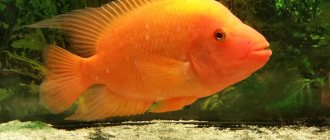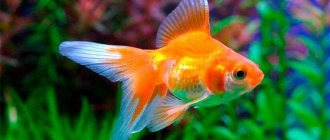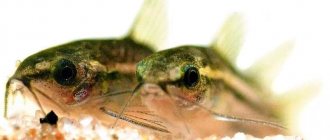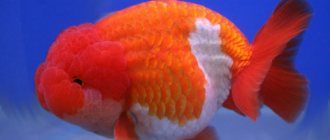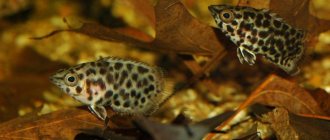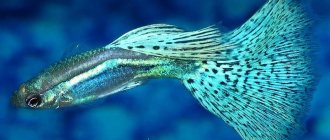Like most African cichlids, this species is primarily suitable for a species-specific biotope aquarium that simulates a specific habitat. The selection of neighbors is extremely limited, if not completely impossible, in relatively small reservoirs.
Requirements and conditions:
- Aquarium volume - from 200 liters.
- Temperature - 23–28°C
- pH value - 7.0-8.0
- Water hardness - medium and high hardness (10–25 dH)
- Substrate type - sand or fine gravel with piles of stones
- Lighting - moderate
- Brackish water - acceptable at 1.0002 concentration
- Water movement - moderate/strong
- Size - up to 15 cm.
- Nutrition - plant food with meat/protein supplements
- Life expectancy is up to 10 years.
Description
Labeotropheus has a large head with a slightly protruding mouth, reminiscent of a “humpbacked” or “hooked” nose. This structure, together with sharp teeth, makes it possible to successfully scrape tough algae from the surfaces of stones and withstand strong flows of water. There are several color variations. The most popular form is blue or light blue with a bright orange or red dorsal fin. The tail usually has a reddish edging. Each male has a characteristic pattern of several yellow round spots on the anal fin.
Beckford's fish
Nannostomus Beckford (also called Nannostomus red) is characterized by an elongated fusiform body, which is slightly flattened laterally. The back of this fish has a reddish-brown color and at the same time gives off a green color. This nanostomus has gray-yellow sides and a white belly with a silvery tint.
From the very mouth of the fish to the base of the tail there is a wide black stripe ending in two spots of bright scarlet color. Along this stripe (above and below) there is a transfusion of the fish with a red, gold, and purple tint.
Nannostomus has colorless pectoral fins, while the remaining fins have a reddish (if male) or pale orange, yellow (if female) base. The fish also have milky blue tips on their ventral fins. All fins, with the exception of the anal fin, have dark rays.
However, at night, Beckford's nanostomus becomes almost transparent, and 3 oval dark spots begin to appear on its body: one of them in the middle of the body, the second near the anal fin, and the third at the very root of the caudal fin.
The fish grow up to 6-7 cm, with females being somewhat larger and males slimmer.
Conditions of detention
This nanostomus thrives if the aquarium is set at 6-7 liters per fish. It is advisable to have a flock of 10-15 fish in the aquarium.
As for compatibility, Nannostomus of the species in question gets along well with small and calm fish. Moreover, keeping it together with other fish is even recommended, since otherwise the fish will begin to lead a secretive lifestyle.
At the same time, plants planted quite densely around the perimeter of the aquarium are needed. They will act as shelters for fish. For a similar purpose, stones and driftwood are placed in the aquarium.
The specific parameters should be as follows:
- temperature in the range of 23-26 degrees;
- 5.5-7.0 is pH;
- 3-15 degrees – hardness.
You can feed the fish with daphnia, bloodworms, cyclops, fruit flies, and tubifex. Regardless of whether the food is dry or live, it must be thoroughly chopped. Before spawning, it is recommended to feed with Drosophila, then this nanostomus will not eat its own eggs.
Nutrition
In the wild, fish eat algae growing on rocks, often together with those who live there - these are various small crustaceans. Therefore, the basis of the diet should be algae (about 95%) with a certain amount of protein food (bloodworms, daphnia, brine shrimp). Both specialized flakes, granules from pet stores, and homemade products are used as plant food: pieces of spinach, broccoli, lettuce, etc. Feed 2-3 times a day in an amount that is eaten in 5 minutes.
Difficult character
It is still not recommended for beginners to have cougars. In a number of situations (for example, when transferred), it can injure its owners. If there is a need to transport it, you need to use a special net made of soft wire or thick twine.
When the fish is well-fed, you can go into its habitat. But only if there are no unhealed cuts or at least a drop of blood on them. Otherwise, the beauty will show that it’s not for nothing that many are afraid of her.
Therefore, letting small children and curious cats get close is also dangerous.
In general, their temperament is contradictory - both aggressive (although not as much as in their native element) and timid. From loud sounds and sudden movements, the piranha even briefly loses consciousness.
Maintenance and care
For a small group of Labeotropheus, the optimal tank is 200 liters or more, designed as a separate rocky section of the coast of Lake Malawi. It looks like this: a sandy substrate and a pile of large stones and pieces of rock reaching the surface. They are located near one of the side walls of the aquarium or as a background. When creating such a structure, be sure to use silicone aquarium glue to hold the stones together to avoid destruction. The fastened fragments must be large enough to form artificial crevices and grottoes, which will serve as an excellent shelter. There is no need for plants; they will be quickly destroyed. The main trouble will come from preparing water. The lake is distinguished by the stability of the hydrochemical composition of the water (pH about 8.0, dH 10–25), which will need to be recreated in your aquarium. Read more about water parameters and how to change them in the “Hydrochemical composition of water” section. In addition to a certain composition, it is also necessary to maintain a low level of contamination; this purpose is served by weekly renewal of water by 10–20% of the tank volume and cleaning the soil of organic waste (excrement, uneaten food residues). The minimum set of equipment includes filtration, lighting, heating and aeration systems. Moreover, each of them is of critical importance, therefore it is mandatory. It is worth noting that a high-performance filter system will increase the frequency of water changes to two weeks, thereby facilitating the maintenance of the aquarium.
Labeotropheus trevavas Tumbi West
Labeotropheus Treways, common, pink.
Habitat in nature
Rocky coast of Lake Malawi.
Description
Under favorable conditions, fish grow up to 18-20 cm, while females are approximately 25% smaller. Their body is elongated, oval, flattened laterally. The head is large with a massive sloping forehead. The mouth is large, lower, the upper lip is strongly developed and hangs over the lower in the form of a beak, there are no teeth.
Body coloration is very variable and depends on the degree of irritation, especially in the male. Males are bluish-blue to violet, the intensity of the blue color gradually intensifies towards the head and on it turns into a thick dark blue color. On the head, on the forehead, between the eyes there are three wide stripes: the middle one is dark blue, and the other two are bright blue.
There are color options: purple, yellow with brown spots, orange-red with brown and reddish spots, black and orange specks. Dark purple and whitish variants are also known (color of both sexes). In one of the color forms, the female is pink. The fry have two color options - light - future females, dark - males. — L. trewavasae “Chirwa” – the body is golden-yellow, the edges of the scales are light blue. The dorsal fin is light blue; — L. trewavasae “Marmalade Cat” – the male has a blue base color with dark blue spotting. The dorsal fin is orange in the front and dark blue near the back.
- L. trewavasae “Mpanga Red” - males are dark orange to red in color with light blue and dark golden sparkles on the scales. All fins have blue rays on a dark blue background; — L. trewavasae “Thumbi West” – the male is bright blue, the dorsal and ventral fins are reddish; — L. trewavasae “Trewavas Red-Finned” are one of the most popular cichlids of this species. The male's body is blue with an orange to red dorsal fin.
The aquarium for keeping labeotropheus must be large - at least 100 liters, otherwise the fish will kill each other. The bottom should be covered with pebbles or coarse sand, and several medium-sized dark flat stones should be placed on top in the form of a pyramid, some of the stones should reach the surface of the water. The stones should be placed closer to the rear glass of the aquarium. The stones should be at a certain distance from each other, forming grottoes and through caves, so that fish can freely climb into the holes formed between them and swim between them.
It is also advisable to place several vinyl chloride pipes with a diameter of 10-15 cm and a length of 15 cm in the aquarium. You can place medium-sized ceramic pots on their sides. This is necessary so that the fish, when arranging shelters for themselves, do not constantly dig into the ground, so that the females can find shelter for themselves and easily hide from the male pursuing her, and also so that they can hatch eggs, hiding in a grotto or pipe. The aquarium should not be heavily planted with plants, since during the spawning period the male begins to dig holes. Protect powerful plants with shortened stems from being pulled out.
The fish are aggressive, territorial, and stay in the middle and lower layers of water. Labeotropheus are very vicious towards each other, especially males. You cannot keep two males in one aquarium, since the stronger one chases the weaker one, eats its fins and kills it. When there is only one female in the aquarium, the male chases her hard all the time, beats her and sometimes kills her. Even in an aquarium with a length of 150 cm, it organizes border skirmishes and tries to expand its territory.
In a small aquarium, the strongest male can kill a weaker one, as well as a female who is not ready for spawning; in addition, fights between females are observed. Therefore, three or four females should be allowed in with one male. It is not advisable to keep males and females separately, since in this case all the beauty of the fish will not be revealed. Fish feel good only in old water with a hardness of 12-15°; lowering the hardness to 6-8° has a detrimental effect on them.
Labeotrophaeus do not tolerate fresh water. If fresh water is added to the aquarium, then after 1.5-2 hours the entire body and head of the fish are covered with bluish-white mucus. They begin to breathe rapidly, scratch their bodies on the sand and stones, their color darkens, then convulsions appear, and the fish die. Therefore, you need to remember that only old or well-settled water (for at least a week) can be added to the aquarium.
Breeding
Labeotropheus successfully reproduces in captivity, spawning takes place quickly and the aquarist can miss the moment and see the finished offspring. During the mating season, the male shows his best coloring, selects and cleans a place on the bottom - the future nest, usually a flat stone. Then he invites the female there, who lays up to 10 large eggs and quickly takes them into her mouth. This behavior has developed evolutionarily in order to protect offspring from external threats and the inability to reliably hide eggs among open rocks. The male is nearby during spawning and flutters his anal fin in a pattern reminiscent of eggs. The female mistakenly tries to take them too, biting the fin; at this moment the male releases milk and fertilization occurs. The incubation period lasts about 3 weeks, all this time the eggs are in the female’s mouth. At first the juveniles stay close to the bottom, but soon begin to swim throughout the aquarium. Feed crushed flakes with a high content of plant components. It is recommended to transplant the fry into a separate tank.
Reproduction
Note that breeding these fish is quite difficult, since females often suffer from obesity, as a result of which they become infertile. That is why it is customary to plant a group of fish with a large number of males for spawning. One pair of fish will require about 10 liters of water. A few days before spawning, males and females are separated from each other, fed generously and periodically changed water, creating an imitation of the rainy season to stimulate spawning. A separator net is placed in the spawning tank, on which a washcloth and small-leaved plants are placed. Spawning water is mixed with distilled water and peat extract is added until a yellowish color is obtained.
The water parameters in the spawning tank must meet the following standards: hardness – 1.5-10°, temperature – 25-27 °C, acidity – 6.0-7.0 pH. An increase in atmospheric pressure also leads to stimulation of spawning. After a few days of the fish staying in the spawning grounds, mating games begin. During one spawning, the female is capable of laying about 200-300 eggs. At the end of spawning, the producers are removed, and most of the water in the spawning tank is replaced with fresh water with the same parameters.
During the development period of the lemon tetra, lighting is contraindicated, so it is better to darken the walls of the aquarium. The incubation period is approximately 1.5 days, and after another three days the fry will begin to swim and feed independently. Starter food for lemon tetra fry is live dust and brine shrimp. That's all the basic knowledge you should have if you want to keep a lemon tetra fish in your aquarium. We hope that our publication today will be useful to you. Good luck with keeping and breeding aquarium fish!
Fish diseases
A typical disease of representatives of Lake Malawi is the disease of the same name - “Malawi Bloat”. The main reason for this is the improper maintenance of fish, this applies to both the parameters/purity of the water and the quality of the feed. In favorable conditions, health problems do not arise. Read more about symptoms and treatment methods in the section “Diseases of aquarium fish”.
Peculiarities
- Aggressive territorial species
- Keeping in a harem with one male and several females
- The diet consists mainly of plant foods
Living water
The owner must monitor the condition and quality of the liquid in which the pet swims. It should not be cold or even warm for a long time. Ideally 26 degrees Celsius with a hardness of 6.5.
To maintain this mode, install a water heater and a thermometer. You also cannot do without a large filter that operates around the clock.
To saturate the aquarium with oxygen you will need aerators. The water is renewed weekly by 10-15%. Depending on the contamination, the procedure is carried out 2 times in 7 days.
Since the toothfish does not pick up leftover food, they are removed to keep it clean. All of these factors are important for maintaining a pet's immune system.
More piranhas
Aquarists are interested not only in keeping, but also in breeding predators. For this process to be successful, they are given high-quality food with the maximum amount of animal feed.
To prepare for spawning, the pair is placed in a separate 300-liter container. For greater comfort, future parents will need a cleaning filter pump. It gives a flow effect, and reproduction occurs as if in a natural environment.
Soil approximately 5 cm thick is poured onto the bottom. In it, the male will dig a hole where the female will begin to spawn.
The water temperature should be plus 28-30 degrees. About a quarter of the total volume is changed daily.
REPRODUCTION
First of all, the aquarium should be in a quiet place where no one will disturb the fish. Further, the fish must be compatible (a long-established school, with a developed hierarchy). For successful spawning, you need very clean water - a minimum of ammonia and nitrates, pH 6.5-7.5, temperature 28 C, and a large aquarium in which the couple can distinguish their own territory.
A pair ready for spawning chooses a spawning site, which it aggressively guards. The piranhas' coloration darkens and they begin to build a nest on the bottom, uprooting plants and moving rocks. Here the female will mark the eggs, which the male will quickly fertilize. After spawning, the male will guard the eggs and attack anyone who approaches it.
The eggs are orange in color and will hatch in 2-3 days. The larva will feed from the yolk sac for another couple of days, after which it will swim. From this moment the fry is placed in a nursery aquarium. Be careful, the male can even attack an object while protecting the fry.
Already as a fry, piranhas are very greedy for food. You need to feed them with Artemia naupilia for the first days, and then add flakes, bloodworms, daphnia, etc. The fry should be fed frequently, two to three times a day. The juveniles grow very quickly, reaching a centimeter within a month.
Mycosis (ringworm)
Mycosis is a disease caused by fungi from the Saprolegniaceae family; they most often affect aquarium fish weakened by other factors. For example: injuries resulting from territorial battles, too low water temperatures and a contaminated aquarium, all of these reasons can affect the fish's immune system to the point that they become infected with fungi. Fungi are not very pathogenic. However, in wounded or weakened fish, the immune system of the mucous membrane is weakened enough to create optimal conditions for the development of fungi. Their skin, eyes, fins and gills may be infected.
With mycosis, as with any other disease, the most important thing is early diagnosis of symptoms and initiation of treatment.
symptoms:
- apathy
- Lack of appetite
- Aversion to swimming, often staying in a shady place in the aquarium while being completely motionless
treatment:
- Move the fish to clean water or install a more efficient water flow (50% or more).
- Adjust the temperature or raise it slightly.
- Prepare sick fish for baths in saline solution (about 1 TL per 1 liter of water) for 15 to 30 minutes or in potassium permanganate solution (1 g per 100 liters of water) for about 30 minutes. Baths should not take place in an aquarium, but in a separate aquarium.
- give vitamins to strengthen the immune system.
- give special antifungal and antibacterial agents.
All diseases are connected by one principle: prevention is better than cure. Proper care of water and fish is the basis for maintaining a healthy and beautiful aquarium.
Types of labeotropheus
Labeotropheus Fuelleborna (tapir cichlid)
A small, relatively calm cichlid up to 12 cm in size. It got its name due to the peculiar shape of its head: there is a depression on the nose. And behind it is something like a step or proboscis. The body of the fish is long, flat on the sides. The head is large with large eyes. The fins are pointed. The color in natural conditions gravitates towards blue tones. But in aquariums there are specimens of different colors: yellow, lilac, orange. There are 9-11 vague dark stripes across the body. The dorsal fin is usually the same color as the scales. And the anal fin is orange, with noticeable yellow egg spots. In captivity, Labeotropheus Fuelleborn can reach a length of 15 cm. Females are somewhat smaller. It is recommended to keep one male and several females. The fish do not show aggression towards their aquarium neighbors of other species. Sexual maturity occurs at approximately one year of age. The fry that emerge from the eggs feed on live dust. Adding it to the water simultaneously with increasing the temperature in the aquarium stimulates spawning.
Remember! Even if you are not interested in breeding fish, it is worth creating conditions for them to spawn so that the males acquire the brightest color possible - once. And secondly, to observe their peculiar behavior during spawning and incubation of eggs, the like of which cannot be found in fish of other families and orders.
Labeotropheus vulgaris
Large (up to 20 cm) aggressive cichlid. Feeds on algae. In addition to ready-made food and fresh greens, it is recommended to place stones in the aquarium so that they partially rise above the water. And install intense lighting: this way they will begin to become overgrown with green algae. Which will become a natural food for the fish. Labeotropheus trevavas (common) has a brighter color than its relative Fuelleborn. Namely, the dorsal fin is bright red, the body can also be reddish. Females are monochromatic, closer to brown, with dark spots. In aquarium conditions, representatives of different species of Labeotropheus are capable of interbreeding, so it is not worth keeping them together. Labeotropheus trevavas has a subspecies called "Chilumba": the males of these fish have brighter orange shades in their fins and scales, and are slightly larger. A characteristic feature of the fish is a fatty growth in the nose area, which resembles a human nose with a hump.
Ichthyophthiriasis
Ichthyophthyriasis is caused by a parasitic protozoan called Ichichyophthirius multifiliis, which burrows into and lives in the mucous membrane of fish. The infection is visible to the naked eye and - thanks to the characteristic white, slightly raised dots - is easily recognized. Therefore, this disease is called "white spot" disease or "semi-automatic" disease. In the advanced stage of the disease, the white spots may join together and form gray spots. The skin then secretes more mucus and begins to move away from the body. If your fish are left untreated, this disease is fatal. It is extremely important to recognize the symptoms early and begin treatment.
symptoms:
- Sleepy uncoordinated movements
- Fins pressed to the body
- Scratching the skin on stones, roots or other elements of the aquarium decor
- Reluctance to eat
- If the gills were also infected: breathing problems begin, rapid breathing (Fish often “hangs” right on the surface of the water and catches air.)
treatment:
- The treatment takes place in the aquarium, because the parasite takes refuge not only on the mucous membrane of the fish, but also on the bottom of the aquarium.
- Increase the temperature to 28-30°C (however, first make sure that all fish and plants in the aquarium are adapted to these temperatures).
- use malachite green, but be sure to turn off the light (the substance is photosensitive).
- Treatment lasts about 14-20 days because treatments can only reach the parasites when they have reached a certain stage of development.

